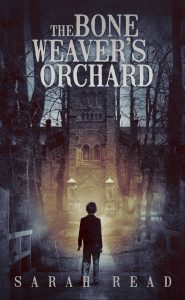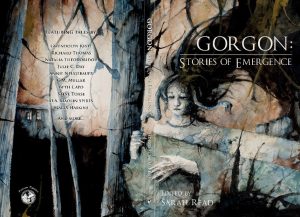Hellnotes: First off, congratulations on the publication of your first novel, The Bone Weaver’s Orchard! While many readers already know your short fiction and have probably heard the excellent buzz around Bone Weaver (including Eden Royce’s review on this site), let’s not leave anyone behind: Could you tell us a little bit about yourself and little bit about the book?
Sarah Read: Hello there and thank you! I’m a dark fiction writer living in the frozen north of Wisconsin. I have two sons, two cats, and a few thousand spiders. My book is a gothic historical horror novel, set in an old abbey-turned-school in Yorkshire, England in 1926. It’s the story of young Charley Winslow and his determination to solve the mystery lurking in the school and save his classmates from the creature that prowls its halls. Of course, secrets have their guardians and creatures have their protectors. And very old houses can hold their own against one curious boy.
HN: The Bone Weaver’s Orchard is Gothic to its bones — it takes place in a crumbling abbey on a misty moor that houses The Old Cross School for Boys, where dark secrets lurk within the walls and a mysterious history rots outwards from the core. Of course, it’s a bit more gruesome than just that, although I hesitate to reveal too much. What was your inspiration behind the novel and your decision to explore this setting? Were there any specific references or touchstones that guided you?
SR: I took the age-old advice, “write the book you want to read” and ran away with it! My love for spiders was a source, and my fascination with big, old houses. My main inspiration was my childhood obsession with Frances Hodgson Burnett’s The Secret Garden. Mary Lennox’s explorations of Misselthwaite Manor—its abandoned rooms, sad past, and uncertain future—captivated me. There’s a bit of Mary in my Charley character, and more than a bit of Ben Weatherstaff in Sam Forster.
My grandmother is an obsessive reader and she passed that on to me. Most of my books were gifts from her. She loves gothic classics and my copy of The Secret Garden used to be her copy. She bought it when I was a year old. It has her embossed foil stamp in it. It has gilded edges, a ribbon bookmark, color plate illustrations, and a leather cover. It’s one of my most treasured belongings.
So of course, I channeled that sweetness and nostalgia—then added twenty shades of darkness and a lot of spiders, because I’m me.
HN: One thing the novel does so well is to build the dusty, decaying atmosphere by laying down one strand at a time like a spider spinning a web. Understanding how difficult it is to reduce a feast down to just a morsel, is there a particular passage that you would like to share with our readers? Perhaps something that whets the appetite or that you think captures the novel’s tone.
SR: Oh, goodness. I keep going to the passages I want and they all have spoilers! So I’ll have to be quite brief…
“The ceiling hung with curtains of cobweb swaying in slow currents of stale air. He pulled a dusty strand of web from the wall and rolled it between his fingers.
‘Theridiidae,’ he whispered, his breath blowing flecks of dust from the old web. He scanned the walls for the bead-black bodies spotted with yellow, their front legs long and hooked. Nothing moved in the silent hall.
Thick layers of dust muffled his footfalls and revealed the dragging tracks of other feet that had walked this way.”
HN: Many readers will probably be most familiar with your work writing short fiction, which has appeared in many wonderful venues. What was it like making the transition from short fiction to the novel? Did you find it to require a fundamentally different kind of approach or was it more a matter of degree? If you had to make the impossible choice and could only write one going forward – short stories or novels?
SR: I tried for years to write a novel, and never could. For some reason all the stories stopped short. I’m not sure what it was that changed in my brain, but this book unrolled at my feet in my first frantic, successful NaNoWriMo attempt. I write in layers, though, so it didn’t begin at full length. The first draft was an armature, and I expanded, unpacked, and slabbed more meat onto its bones over the course of five years of revisions and rewrites.
I use the same process for short stories, but of course I have to reign things in a bit more and keep structure and pace in mind for that length. The novel I’m writing now began as a short story idea that ran away with me. I realized it was unfolding into something with too many legs for short form.
Pick one? You’re cruel. And I’m not sure it would ever be up to me, anyway—the stories end or expand without my permission more often than not. But I’m falling in love with writing novels. I like having permission and space to be more descriptive and build worlds.
HN: Because The Bone Weaver’s Orchard takes place in a crumbling boys’ school on the moors, readers wouldn’t be wrong to anticipate that it touches on a number of Gothic horror tropes. I don’t want to list them out, since part of the creepy fun of the novel is seeing them emerge and develop in different ways, but in general what was it like working in such a well-established arena? What kinds of benefits or challenges did you find in working within such a well-established arena?
SR: Haha, I will not deny that this is a trope-y book! Gothic is my favorite literary playground, both for reading and writing. I hope my love for it shines through and does it some justice. This book is unapologetically gothic—I didn’t even try to reign it in. I think “trope” has become a word people sometimes use when they mean “cliché”. I certainly hope my book isn’t that, but it is definitely a celebration of the gothic. Of course, when I wrote it, I didn’t actually think anyone would ever read it… So this is what happens when I write to entertain myself.
HN: Just like the Old Cross School itself, this novel is filled with twists and turns and secret passages. Not only does the school have its hidden stairways and dark tunnels, but the characters, too, have hidden connections and dark histories just below the surface. How did you keep these physical and narrative connections straight while writing the novel? Did you do a lot of planning in advance, or did it come about organically and then require some surgery in the editing phase?
SR: I did some planning ahead of time, but a lot of it then twisted away from me. I hand write all my work, though, so I was able to leave myself notes in the margins about the things that were changing, then go back and make sure they were woven in where it was needed. So, a lot of surgery, yeah! I ended up keeping a separate notebook for revision notes and developmental brainstorming. That notebook ended up looking like it had been through a war. I guess it had been, in a way.
To keep the school passages straight, I ended up having to draw blueprints of the entire school. It’s very easy to get lost inside the walls and tunnels! Sometimes it felt like an Escher castle.
HN: In addition to writing, you are also the editor of Pantheon Magazine (and the newest issue Gorgon: Stories of Emergence is out now!). What has being an editor—particularly the process of reading many, many submissions—helped you to see in your own writing? What kind of challenges do you see as an editor in trying to get a diverse and well-rounded collection of fiction? Beyond representational demographics, what’s it like to try to pull together different kinds of stories that might be outside of the variety that you yourself would normally write?
SR: I’m so proud of the lineup in Gorgon! We received almost 700 submissions for the book, so while it was agony narrowing it down to the best 42, there came a point where it was a matter of choosing between only excellent stories, and the excitement of knowing what an amazing book it would be kept us going. I can’t speak for other publications’ submission queues, but we had a beautifully diverse list of submissions. I didn’t do anything special to obtain that other than advertise the open call as widely as possible and make sure it was clear in our guidelines that we love stories from diverse voices. I feel pretty comfortable saying that any editor that fails to put together a diverse TOC is not performing even the most basic elements of their job.
HN: I would be remiss if I didn’t note that you are also unabashed in your enthusiasm for fountain pens and their associated paraphernalia. Two questions: First, do you think that there’s a connection between your interest in both being a writer and in the mechanics of writing (and if, so, did one precede the other)? Second, what’s a good entry-level fountain pen recommendation for our readers who might be waiting to jump into the well?
SR: Totally unabashed! And very enthusiastic, yes. There are definitely days where I don’t really know what I want to write, but the sheer pleasure of putting a nice pen to paper makes me sit down and write anyway. I have written stories that would never have existed if I hadn’t been desperate to try out a new ink. I don’t honestly know which came first! As soon as I could write, I was writing silly poems and stories. I’ve treasured fresh stationery for as long as I remember. I don’t always need a fancy pen—a freshly sharpened pencil is every bit as tempting.
HN: Finally, what’s coming up next for you? Not just your concrete releases or scheduled projects, but something that’s still in the ephemeral stage. Make a wild guess: In what heretofore uncharted directions do you think you might head?
SR: Ooh, the future future! There is an idea for a series tickling my brain at the moment. It’s inspired by my obsession with ghost hunter shows. Right now, it’s just a sparkling carrot on the end of a stick, forcing me to wrap up all my current works so I can dig in.
Those current works include the final touches on my debut collection that will be out from Trepidatio Publishing later this year, a novel that’s moving into draft three, a few short stories that were requested by editors, and a novel that is currently being drafted. Lots to do! Good thing I have a lifetime supply of ink.
Sarah Read is a dark fiction writer in the frozen north of Wisconsin. Her short stories can be found in Gamut, Black Static, and other places, and in various anthologies including Exigencies, Suspended in Dusk, BEHOLD! Oddities Curiosities and Undefinable Wonders, and The Best Horror of the Year Vol 10. Her novel The Bone Weaver’s Orchard is now out from Trepidatio Publishing, and her debut collection will follow in late 2019. She is the Editor-in-Chief of Pantheon Magazine and of their associated anthologies, including Gorgon: Stories of Emergence. She is an active member of the Horror Writers Association. When she’s not staring into the abyss, she knits.
Website: https://inkwellmonster.wordpress.com/
Facebook: https://www.facebook.com/sarah.read.7505
Twitter: https://twitter.com/Inkwellmonster
Instagram: https://www.instagram.com/inkwellmonster/
Gorgon: Stories of Emergence: https://www.amazon.com/Gorgon-Stories-Emergence-Pantheon-Magazine-ebook/dp/B07N7PB75R/
The Bone Weaver’s Orchard: https://www.amazon.com/Bone-Weavers-Orchard-Sarah-Read-ebook/dp/B07MBWSFMS/











